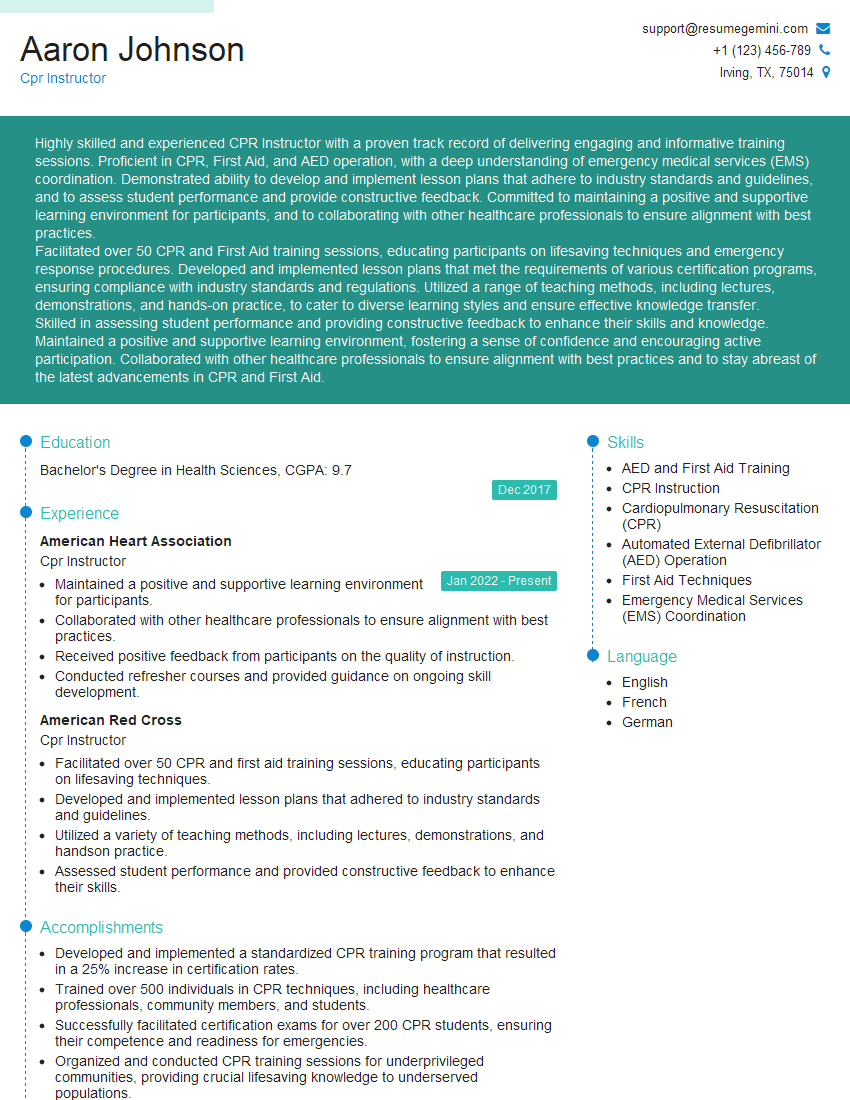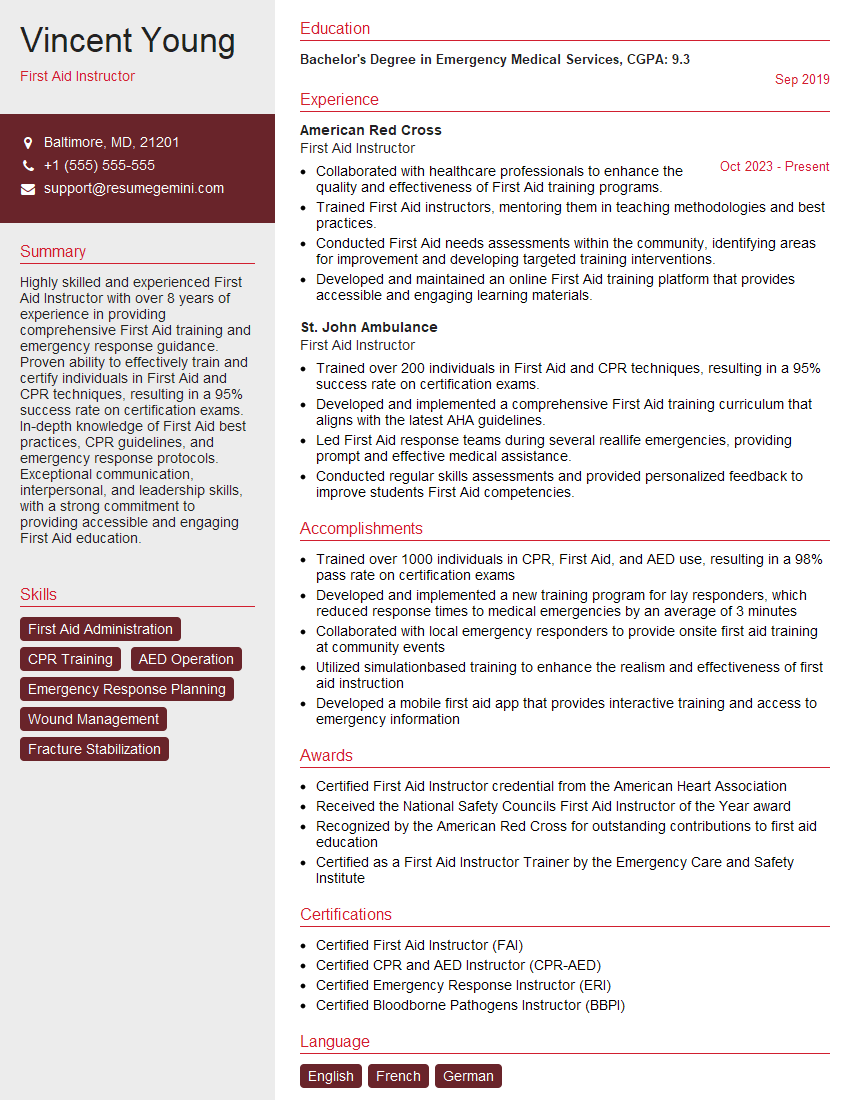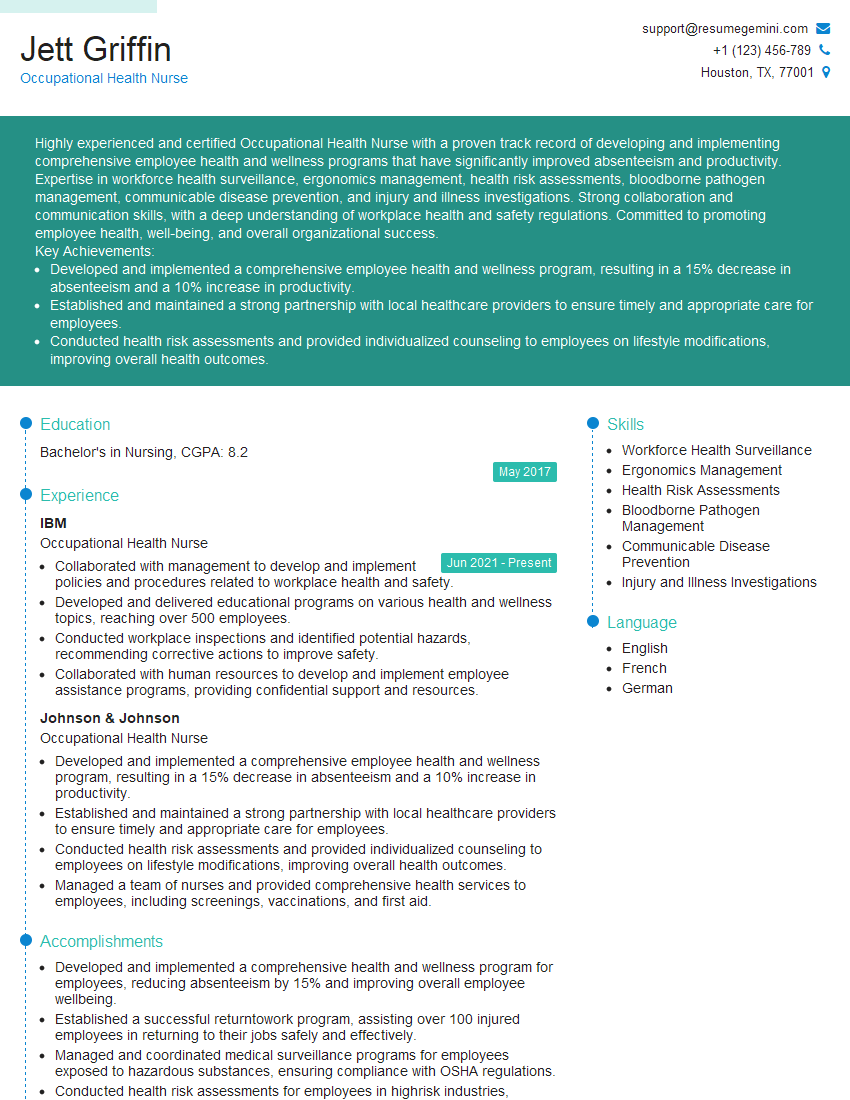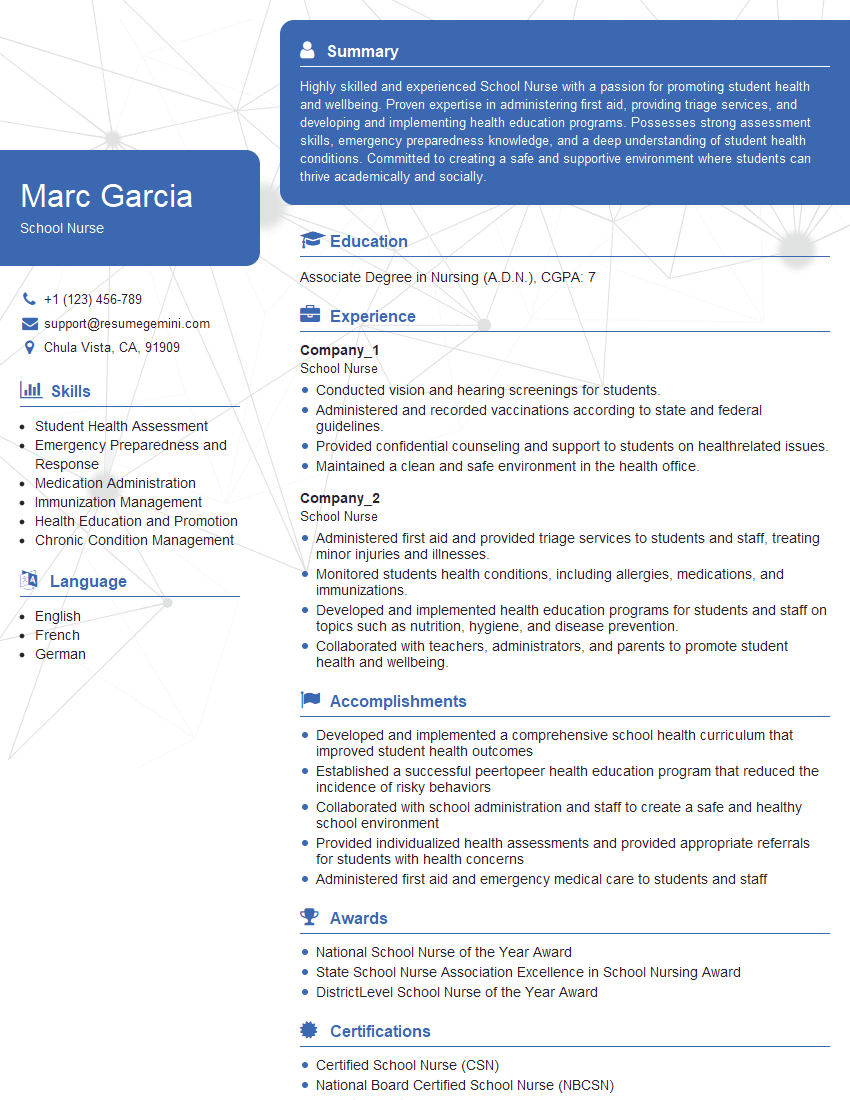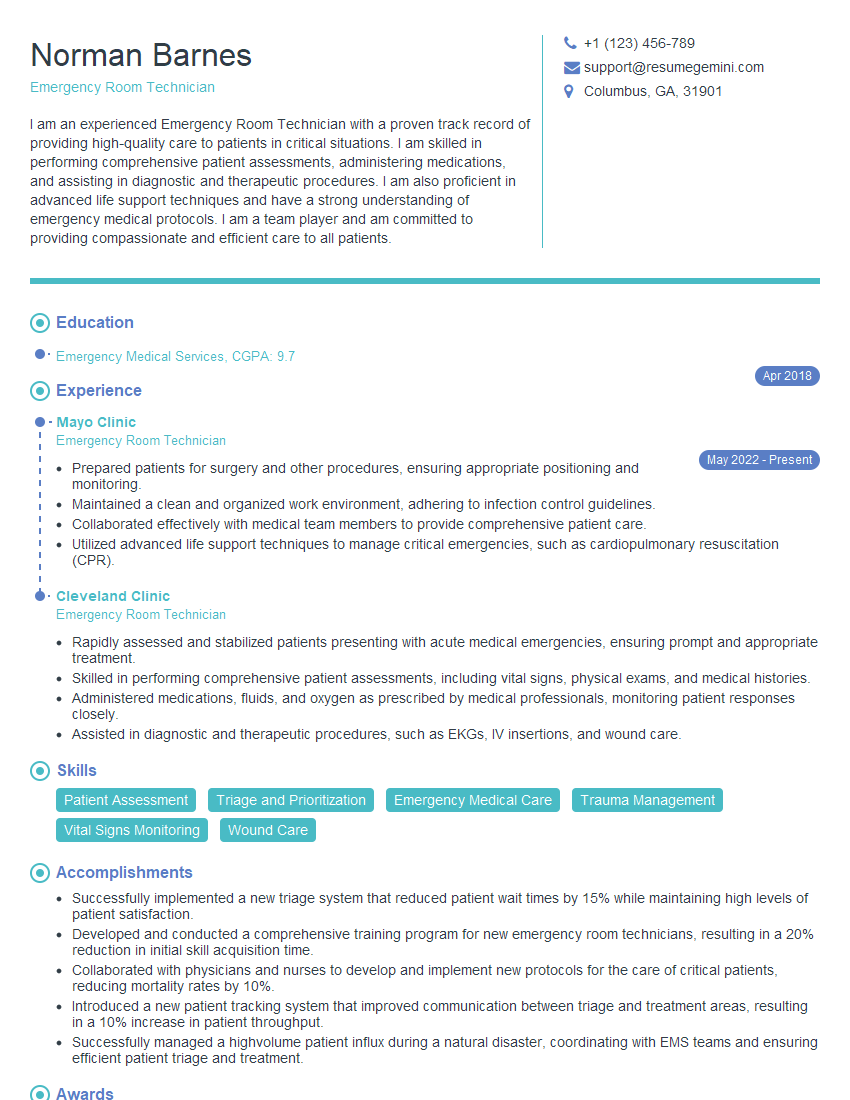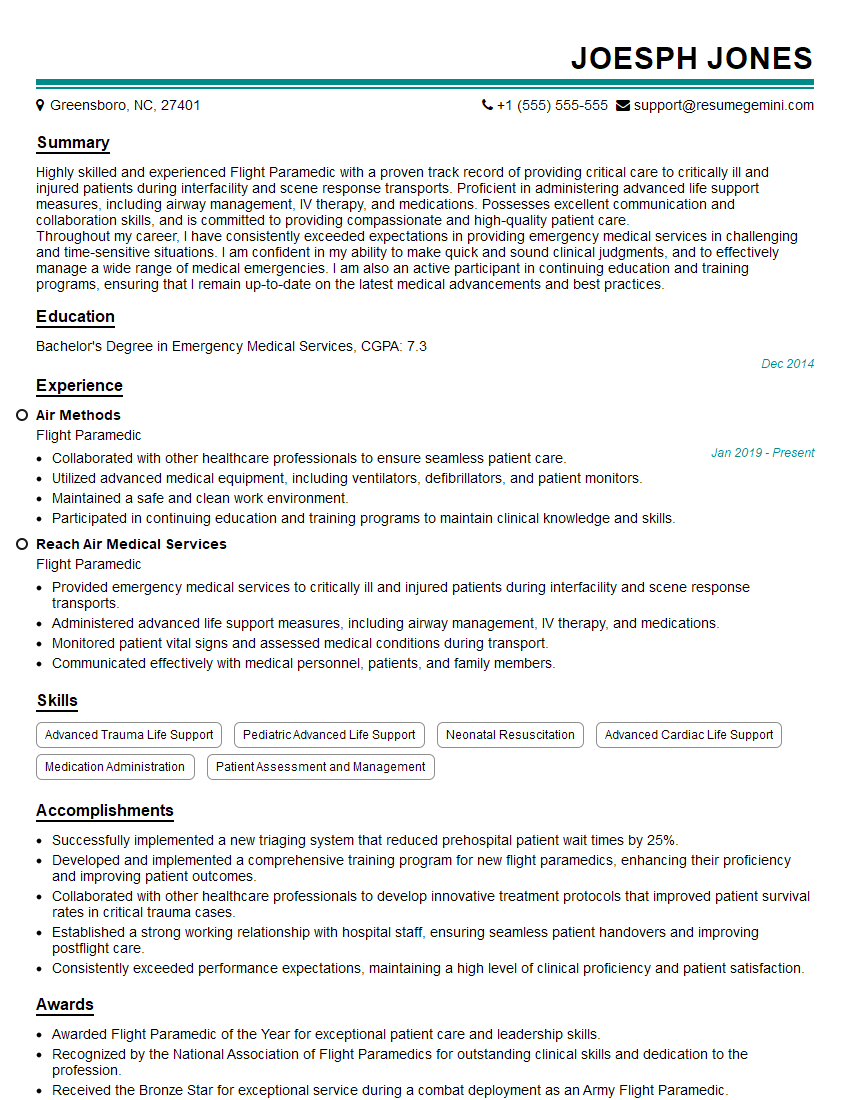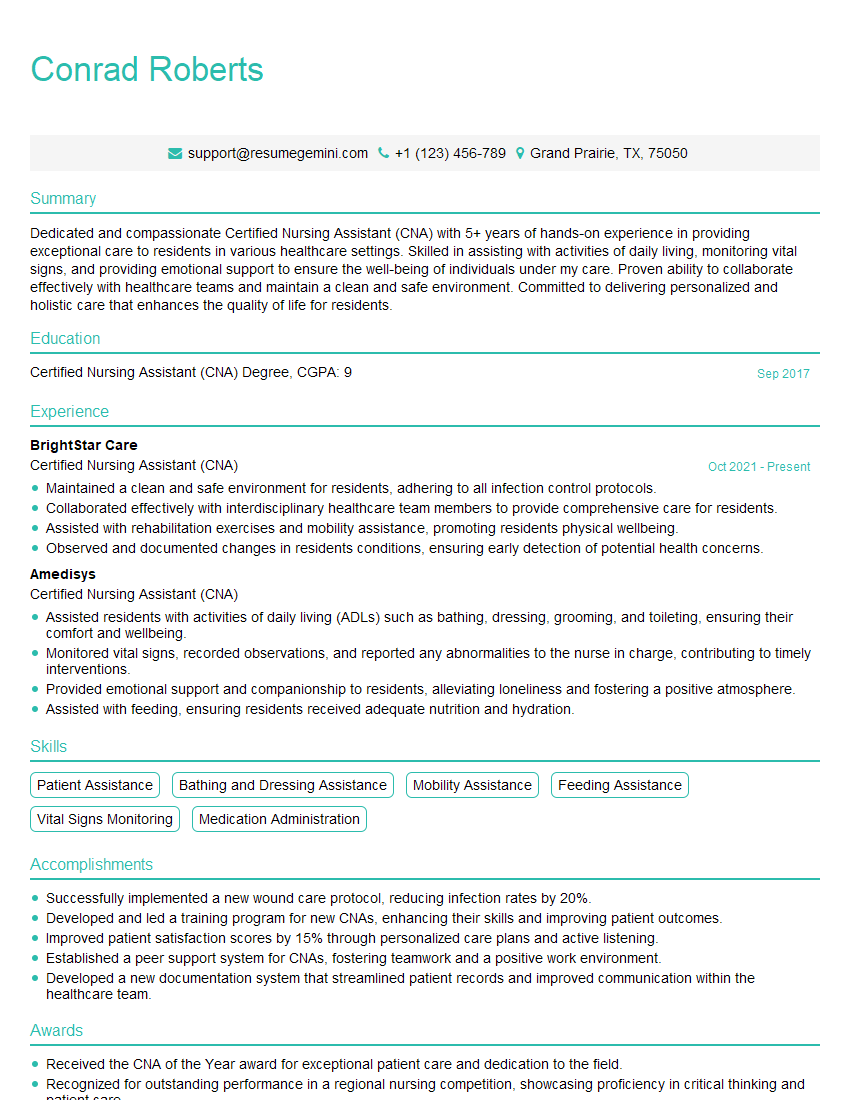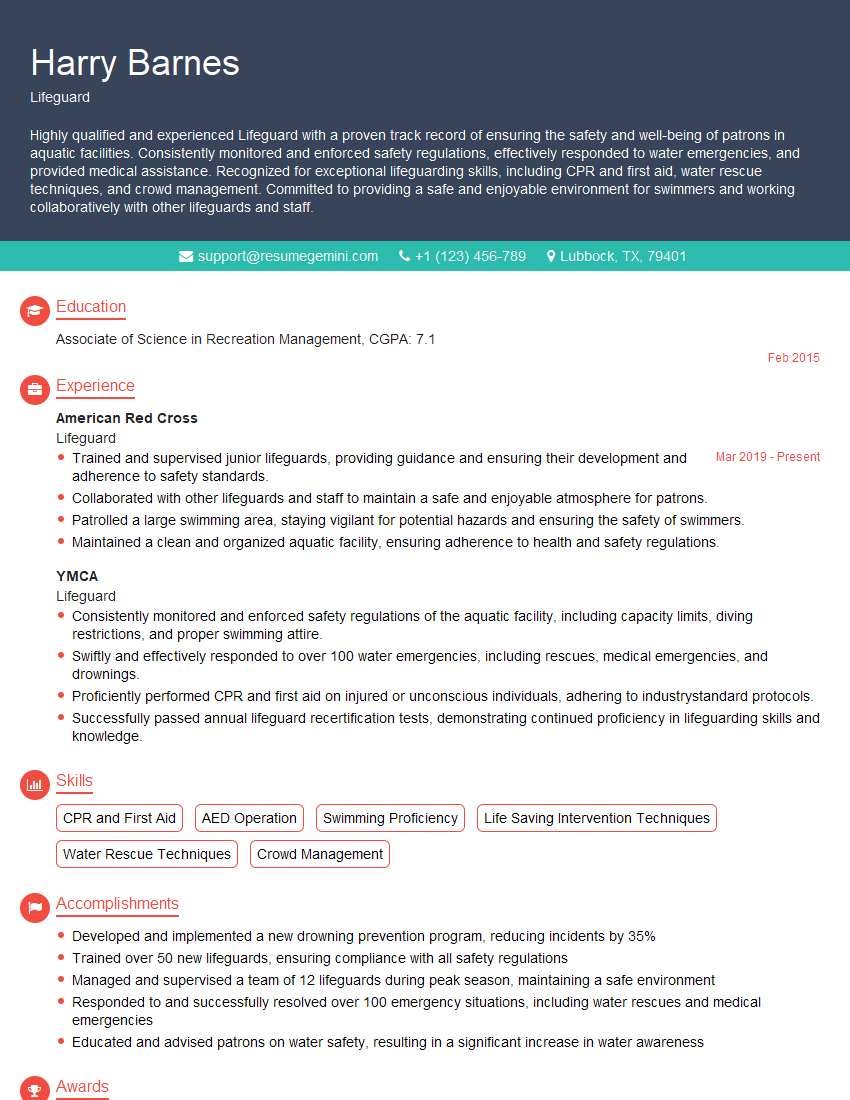Interviews are opportunities to demonstrate your expertise, and this guide is here to help you shine. Explore the essential Basic Medical Aid interview questions that employers frequently ask, paired with strategies for crafting responses that set you apart from the competition.
Questions Asked in Basic Medical Aid Interview
Q 1. Describe the steps involved in performing CPR on an adult.
Performing CPR (Cardiopulmonary Resuscitation) on an adult is a life-saving technique used when someone stops breathing or their heart stops beating. It involves a combination of chest compressions and rescue breaths. Remember, always call emergency services (911 or your local equivalent) immediately before starting CPR.
- Check for Responsiveness: Gently shake the person and shout, “Are you okay?” If there’s no response, move to the next step.
- Call for Help: Have someone call emergency medical services while you begin CPR. If you’re alone, perform CPR for 2 minutes before calling.
- Check for Breathing and Pulse: Look, listen, and feel for normal breathing for no more than 10 seconds. If there’s no normal breathing or pulse, start chest compressions.
- Chest Compressions: Position your hands in the center of the chest, interlacing your fingers. Keep your arms straight and push hard and fast at a rate of at least 100 compressions per minute, allowing the chest to fully recoil after each compression. Aim for a depth of at least 2 inches (5 cm).
- Rescue Breaths (Optional, if trained): If trained and comfortable, give 2 rescue breaths after every 30 chest compressions. Seal the person’s mouth and nose with your mouth and give breaths lasting approximately 1 second each, ensuring visible chest rise.
- Continue CPR: Repeat cycles of 30 compressions and 2 breaths until emergency medical services arrive or the person shows signs of life (like breathing or coughing).
Example: Imagine finding a colleague unconscious at work. You quickly check for responsiveness, call 911, assess breathing and pulse, and begin CPR according to the steps above. Every second counts, and your quick actions can significantly increase the chances of survival.
Q 2. Explain the differences between stable and unstable side positions.
Both the stable and unstable side positions are recovery positions used to help maintain an open airway and prevent choking in unconscious individuals who are breathing and have no spinal injury. The key difference lies in the level of stability and the situations where each is most appropriate.
- Stable Side Position (Recovery Position): This position is used for individuals who are breathing normally and have no suspected spinal injuries. It helps prevent aspiration (vomit or fluids entering the lungs) and keeps the airway open. It involves carefully rolling the person onto their side, supporting their head and neck.
- Unstable Side Position: This is not a standard term in Basic Medical Aid. If a person is unstable (e.g., severely injured or showing signs of shock), their position should be carefully managed by qualified professionals and may involve spinal immobilization techniques to prevent further harm.
In essence: The stable side position is a basic first-aid technique for unconscious breathing individuals. There’s no established ‘unstable side position’ in recognized first-aid protocols. If someone is unstable, focus on managing their immediate life-threatening issues and leave positioning to paramedics.
Q 3. How do you control bleeding from a deep laceration?
Controlling bleeding from a deep laceration is crucial to prevent shock and potential death. The method depends on the severity and location of the wound. Always wear gloves if possible.
- Direct Pressure: Apply firm, direct pressure to the wound using a clean cloth or dressing. Elevate the injured limb above the heart to help reduce bleeding. Do not remove the cloth if it becomes soaked with blood; instead, add more dressings on top and continue applying pressure.
- Pressure Points: If direct pressure is not enough to control the bleeding, consider applying pressure to a pressure point — a location where a major artery is close to the skin’s surface. Examples include the brachial artery (inner arm) or femoral artery (groin). Apply pressure using your fingers or thumb. Note that applying pressure to these points requires specific training.
- Tourniquet (Last Resort): As a last resort, a tourniquet can be applied approximately 2 inches above the wound. This is a life-saving technique that should only be used if direct pressure and pressure point application fails and major bleeding continues to threaten the patient’s life. Remember, a tourniquet is a serious intervention and can cause damage if improperly applied. It should be applied only by trained personnel or in dire emergency situations. Once applied, record the time.
Example: Imagine a person severely cuts their leg. You apply direct pressure with a clean cloth, elevate their leg, and continue applying pressure until the bleeding stops or emergency services arrive. If bleeding is uncontrollable, a tourniquet may be necessary in a severe case, and should only be done when life is threatened by the blood loss.
Q 4. What are the signs and symptoms of a stroke?
A stroke occurs when blood supply to part of the brain is interrupted or reduced, leading to brain cell damage. Recognizing the signs and symptoms is crucial for timely intervention, as prompt treatment can significantly improve the chances of recovery.
- Facial Drooping: One side of the face may droop or be numb.
- Arm Weakness: Weakness or numbness in one arm.
- Speech Difficulty: Slurred speech or difficulty speaking.
- Sudden Severe Headache: A sudden, severe headache with no known cause.
- Confusion or Dizziness: Sudden confusion or dizziness.
- Vision Problems: Sudden vision changes in one or both eyes.
- Loss of Coordination: Difficulty walking or loss of coordination.
Remember the acronym FAST: Facial drooping, Arm weakness, Speech difficulty, Time to call emergency services. If you suspect a stroke, call emergency services immediately. Time is brain.
Example: If a person suddenly experiences a drooping face, weakness in their arm, and difficulty speaking, these are clear signs of a potential stroke. Calling 911 immediately is crucial.
Q 5. How do you assess a patient’s airway, breathing, and circulation (ABCs)?
Assessing a patient’s airway, breathing, and circulation (ABCs) is a fundamental step in providing basic medical aid. It helps determine the patient’s immediate life-threatening conditions.
- Airway: Check if the airway is open and clear. Look for any obstructions such as vomit, blood, or loose dentures. Gently tilt the head back and lift the chin to open the airway if the patient is unconscious and you do not suspect a spinal injury. Do not perform head tilt-chin lift if a spinal injury is suspected.
- Breathing: Look, listen, and feel for normal breathing for no more than 10 seconds. Check for chest rise and fall, and listen for breath sounds. If the patient is not breathing normally, start rescue breathing.
- Circulation: Check the patient’s pulse (carotid pulse is checked in unconscious patients; radial pulse is checked in conscious patients). Assess skin color (pale, cyanotic, or flushed) and skin temperature (cold, clammy or warm). Note presence of any external bleeding.
Example: Upon approaching an unconscious person, you first check their airway for obstruction, then assess their breathing by looking for chest rise and fall. Finally, you check their pulse and skin for signs of circulation. If any of these are compromised, immediate action is required.
Q 6. Explain the use of an Automated External Defibrillator (AED).
An Automated External Defibrillator (AED) is a portable device that delivers an electric shock to the heart to restore a normal heart rhythm in cases of sudden cardiac arrest. AEDs are designed to be user-friendly and are crucial in improving survival rates.
- Turn on the AED: Turn on the device and follow the voice prompts.
- Attach Pads: Attach the adhesive pads to the patient’s bare chest according to the AED’s instructions (usually one pad on the right upper chest and one pad on the left lower rib cage).
- Analyze the Heart Rhythm: The AED will analyze the heart rhythm. Do not touch the patient during this analysis.
- Deliver Shock (if advised): If the AED advises delivering a shock, ensure no one is touching the patient and press the shock button.
- Perform CPR: After the shock, immediately begin CPR (chest compressions and rescue breaths, if trained) for the amount of time suggested by the AED.
- Continue Cycles: Continue cycles of CPR and AED shocks as directed by the device until emergency services arrive or the patient recovers a normal heart rhythm.
Important Note: AEDs are only used for individuals in cardiac arrest, not just for people who are unconscious or having breathing difficulties. Always follow the device’s instructions carefully.
Example: In a scenario of sudden cardiac arrest, an AED would be immediately applied, analyzed, and used to deliver a shock if necessary, followed by CPR to attempt to restore normal heart rhythm. The AED’s instructions are critical throughout the process.
Q 7. What are the key steps in managing a patient with a suspected spinal injury?
Managing a patient with a suspected spinal injury requires careful handling to prevent further damage to the spinal cord. The primary goal is to immobilize the spine and prevent movement.
- Assess the Scene: Before approaching, ensure the scene is safe.
- Minimal Movement: Minimize movement of the patient as much as possible. Do not attempt to move the patient unless there is immediate danger.
- Stabilization: If possible, carefully stabilize the patient’s head and neck. Use manual stabilization by gently supporting the head and neck to prevent movement, without twisting the head or neck. Ideally, use a cervical collar if available and qualified to do so.
- Call for Help: Immediately call emergency medical services.
- Monitor ABCs: Continuously monitor the patient’s airway, breathing, and circulation.
- Avoid unnecessary movement: Do not attempt to remove the helmet from a patient involved in a motor vehicle accident. Avoid unnecessary moving or handling of the victim while waiting for paramedics.
Example: A person is involved in a car accident and is suspected of having a spinal injury. You approach cautiously, minimize movement, manually stabilize their head and neck to the best of your ability, call for emergency services, and monitor breathing and circulation while awaiting their arrival. Moving the patient incorrectly would risk potentially fatal spinal damage.
Q 8. How do you treat a patient experiencing an allergic reaction?
Treating an allergic reaction, also known as anaphylaxis, is a life-threatening emergency requiring immediate action. The severity varies greatly, from mild hives to full-blown respiratory distress. The cornerstone of treatment is the administration of epinephrine (adrenaline), followed by supportive care.
- Identify the allergen if possible: Knowing the allergen helps prevent future exposure.
- Administer Epinephrine (EpiPen): If the patient carries an EpiPen or similar auto-injector, assist them in using it according to the instructions. This is crucial as it reverses the effects of the allergic reaction.
- Call Emergency Medical Services (EMS): Even after administering epinephrine, always call for immediate medical attention. The reaction may worsen, and ongoing monitoring and treatment are vital.
- Maintain Airway: If breathing is difficult, consider placing the patient in a recovery position to help maintain an open airway and prevent choking.
- Monitor Vital Signs: Continuously monitor the patient’s breathing, pulse, and level of consciousness until EMS arrives.
- Supportive Care: This includes oxygen administration if breathing is labored, managing any associated symptoms like nausea or vomiting, and keeping the patient calm and reassured.
Example: Imagine a patient experiencing a bee sting with swelling of the face and difficulty breathing. Immediately administer epinephrine if available, call 911, and monitor vital signs until professional medical help arrives.
Q 9. Describe the procedure for splinting a fractured limb.
Splinting a fractured limb aims to immobilize the injury, minimizing pain and preventing further damage to surrounding tissues and blood vessels. The process involves supporting the injured area in a stable position.
- Assess the injury: Before splinting, carefully assess the injury. Do not attempt to straighten a deformed limb.
- Gentle handling: Avoid unnecessary movement or manipulation of the fractured limb.
- Splint application: Use a rigid material like a piece of wood, cardboard, or a commercially available splint. The splint should extend beyond the joints above and below the fracture.
- Padding: Place padding (cloth, rolled towels) between the splint and the limb to avoid pressure points and enhance comfort.
- Secure the splint: Use bandages or straps to firmly secure the splint to the limb, ensuring it’s snug but not too tight to restrict blood flow.
- Check for circulation: After splinting, check the circulation distal to the fracture site (fingers or toes) to ensure blood flow isn’t compromised. Look for color, warmth, and the ability to feel.
Example: For a suspected broken forearm, you would splint from the elbow to the wrist, ensuring the hand is supported and circulation is maintained. Remember, proper splinting requires training and practice.
Q 10. What are the different types of shock, and how are they treated?
Shock is a life-threatening condition where the body’s tissues and organs aren’t receiving enough blood flow. Different types of shock stem from various causes:
- Hypovolemic Shock: Caused by significant blood or fluid loss (e.g., severe bleeding, dehydration). Treatment involves fluid replacement (IV fluids) and addressing the source of blood loss.
- Cardiogenic Shock: The heart’s inability to pump enough blood (e.g., heart attack, heart failure). Treatment focuses on supporting heart function, often with medications and potentially advanced procedures.
- Anaphylactic Shock: A severe allergic reaction. Treatment involves epinephrine administration (EpiPen) and supportive measures.
- Septic Shock: A life-threatening condition caused by an overwhelming infection. Treatment requires broad-spectrum antibiotics and supportive care to maintain organ function.
- Neurogenic Shock: Caused by damage to the nervous system (e.g., spinal cord injury). Treatment focuses on managing the underlying cause and maintaining blood pressure.
General Treatment Principles for Shock: Regardless of the type, treatment involves maintaining airway, breathing, and circulation (ABCs), providing oxygen, keeping the patient warm, and rapid transport to a medical facility.
Q 11. How do you recognize and manage heat stroke?
Heat stroke is a severe medical emergency resulting from the body’s inability to regulate its temperature. It’s characterized by a dangerously high body temperature (above 104°F or 40°C), often accompanied by altered mental status (confusion, delirium, seizures).
- Recognize the signs: High body temperature, altered mental status, headache, dizziness, nausea, rapid pulse, and possibly seizures.
- Immediate cooling: This is the most critical aspect. Remove excess clothing, apply cool compresses to the neck, groin, and armpits, and fan the patient. Consider immersing the patient in cool water (not ice water) if possible and safe.
- Monitor vital signs: Continuously monitor temperature, pulse, and breathing rate.
- Transport to hospital: Heat stroke requires immediate medical attention. Call EMS immediately.
- Fluid replacement: Once stable, offer cool fluids (electrolyte-rich solutions are better than plain water) to help rehydrate the patient.
Example: A construction worker collapses on a hot day, showing signs of confusion and high temperature. Rapid cooling measures are essential to prevent irreversible brain damage.
Q 12. How do you recognize and manage hypothermia?
Hypothermia is a dangerous drop in the body’s core temperature, occurring when the body loses heat faster than it can produce it. Symptoms range from mild shivering to life-threatening loss of consciousness.
- Mild Hypothermia (90-95°F or 32-35°C): Shivering, confusion, clumsiness.
- Moderate Hypothermia (82-90°F or 28-32°C): Impaired coordination, slowed breathing and heart rate, drowsiness.
- Severe Hypothermia (below 82°F or 28°C): Loss of consciousness, weak pulse, irregular breathing, possible cardiac arrest.
Management:
- Gentle warming: Move the person to a warmer environment. Remove wet clothing.
- Passive rewarming: Wrap the person in warm blankets, use body heat (if appropriate and safe).
- Active rewarming: Use warm water bottles or heating pads (avoid direct contact with skin to prevent burns).
- Avoid sudden warming: Rapid warming can trigger dangerous heart rhythm disturbances.
- Monitor vital signs: Closely watch breathing and pulse.
- Medical attention: Seek immediate medical attention, particularly in moderate and severe cases.
Example: A hiker stranded in a blizzard experiencing shivering, slurred speech, and confusion needs immediate rescue and warming.
Q 13. What are the signs and symptoms of a heart attack?
A heart attack, or myocardial infarction, occurs when blood flow to a part of the heart muscle is blocked, typically by a blood clot.
- Chest pain or discomfort: Often described as pressure, squeezing, fullness, or pain. It can radiate to the arm, jaw, neck, or back.
- Shortness of breath: Difficulty breathing, even at rest.
- Sweating: Excessive sweating, often cold and clammy skin.
- Nausea or vomiting: Feeling sick to the stomach.
- Lightheadedness or dizziness: Feeling faint or weak.
- Denial: Some patients may experience discomfort without realizing it’s a heart attack.
Management:
- Immediate call to emergency services: This is crucial.
- Chew and swallow aspirin (unless contraindicated): Aspirin helps thin the blood and can potentially reduce the extent of the heart muscle damage.
- Rest and monitor vital signs: Keep the patient calm and comfortable, monitoring breathing and pulse.
Note: Women can experience atypical heart attack symptoms like fatigue, indigestion, and back pain. Any sudden, unexplained chest discomfort or shortness of breath requires immediate medical attention.
Q 14. What is the proper technique for bandaging a wound?
Proper wound bandaging aims to control bleeding, protect the wound from further contamination, and provide support to facilitate healing.
- Clean hands and gloves: Always practice proper hygiene.
- Clean the wound: Gently clean the wound with sterile saline or clean water, removing any visible debris. Do not scrub.
- Control bleeding: Apply direct pressure to the wound using a clean dressing. Elevate the injured limb if possible.
- Apply dressing: Use a sterile dressing of appropriate size to cover the wound completely.
- Secure the bandage: Use a bandage to hold the dressing firmly in place. Ensure the bandage is snug but not too tight to cut off circulation.
- Monitor for infection: Regularly check the wound and bandage for signs of infection (increased pain, swelling, redness, pus).
Example: A minor cut on the hand requires a small sterile dressing secured with a bandage. A larger, deeper wound may require more extensive bandaging and medical attention.
Q 15. Explain how to treat a severe nosebleed.
Treating a severe nosebleed requires a calm and methodical approach. The key is to control the bleeding and prevent further complications. First, have the person sit upright, leaning slightly forward to prevent blood from going down the throat, which can cause vomiting or aspiration. Then, pinch the nostrils firmly just below the bony part of the nose for at least 10-15 minutes, continuously. Use a tissue to catch the blood.
- Do not let the person lie down as this can increase blood flow to the nose.
- Do not pack the nostrils with anything except sterile gauze if appropriately trained.
- Do not tilt the head back; this can allow blood to flow down the throat.
After 15 minutes, gently release the pressure. If bleeding continues, repeat the process for another 10-15 minutes. If bleeding persists or is severe despite these measures, immediate medical attention is crucial. Think of it like this: pinching the nostrils is like applying direct pressure to a wound – it helps to clot the blood vessels.
If the bleeding is accompanied by other symptoms, such as a head injury, difficulty breathing, or signs of shock (pale, clammy skin, rapid pulse), seek immediate emergency medical help. A persistent nosebleed can indicate a more serious underlying condition.
Career Expert Tips:
- Ace those interviews! Prepare effectively by reviewing the Top 50 Most Common Interview Questions on ResumeGemini.
- Navigate your job search with confidence! Explore a wide range of Career Tips on ResumeGemini. Learn about common challenges and recommendations to overcome them.
- Craft the perfect resume! Master the Art of Resume Writing with ResumeGemini’s guide. Showcase your unique qualifications and achievements effectively.
- Don’t miss out on holiday savings! Build your dream resume with ResumeGemini’s ATS optimized templates.
Q 16. How do you manage a patient who is experiencing a seizure?
Managing a patient experiencing a seizure focuses on ensuring their safety and preventing further injury. First, protect the person from immediate harm by moving any nearby objects that could cause injury. Then, gently place them on their side to help them breathe easily and prevent choking on vomit or saliva. This position is known as the recovery position.
- Do not restrain the person or try to stop the seizure physically. Their movements are uncontrolled, and forceful intervention could cause harm.
- Do not put anything in their mouth, including your fingers. You could be bitten or obstruct their airway.
- Do not give them food or drink during or immediately after a seizure.
Time the seizure. Note the time it starts and when it ends. Once the seizure is over, monitor their breathing and level of consciousness. If they don’t regain consciousness promptly or the seizure lasts longer than 5 minutes, immediately call emergency medical services.
After the seizure, the individual might experience a period of confusion or sleepiness; this is known as the post-ictal state. Comfort them and stay with them until they fully recover. Documentation of the event, including duration, symptoms observed, and post-ictal state, is crucial for medical professionals.
Q 17. What are the steps in managing a patient with a suspected concussion?
Managing a suspected concussion involves a multi-step approach prioritizing the safety and well-being of the patient. The initial assessment focuses on the ABCs: airway, breathing, and circulation. Assess for any obvious injuries and immediate life threats. Then, carefully observe the person for symptoms of a concussion, such as headache, dizziness, nausea, vomiting, balance problems, confusion, memory loss, or changes in behavior.
- Keep the patient still and monitor vital signs.
- Immobilize the neck if there’s a suspicion of spinal injury.
- Do not give any medication without medical advice.
- If there are signs of severe head injury (loss of consciousness, persistent vomiting, unequal pupils), call emergency services immediately.
Next, gather information about the mechanism of injury – how the injury occurred. This helps medical professionals determine the potential severity. Once stabilized, the patient should be transported to a medical facility for a thorough evaluation. Immediate medical attention is crucial to rule out more serious conditions and to implement appropriate management and prevent long-term complications.
Think of a concussion like a mild traumatic brain injury. The brain has been rattled and needs rest and observation. Ignoring a concussion can lead to serious consequences.
Q 18. Describe the appropriate method for assessing a patient’s level of consciousness.
Assessing a patient’s level of consciousness is a fundamental skill in basic medical aid. We use the AVPU scale:
- Alert: The person is awake, aware of their surroundings, and responsive.
- Verbal: The person responds to verbal stimuli, but may be confused or disoriented.
- Pain: The person responds only to painful stimuli, such as a sternal rub (rubbing the breastbone).
- Unresponsive: The person does not respond to any stimuli.
If a person is unresponsive, further assessment involves checking for breathing and a pulse. Then, immediately initiate CPR if needed. The AVPU scale provides a quick and efficient way to gauge the patient’s neurological status and guide the subsequent management.
Q 19. What is your experience with managing different types of wounds?
My experience with wound management encompasses a range of wound types, from minor abrasions to more serious lacerations. The approach always begins with assessing the wound for severity, location, and any signs of infection. Controlling bleeding is paramount. Direct pressure using a clean dressing is generally effective for minor bleeding.
- Minor wounds: Cleaning with soap and water, applying an antiseptic, and covering with a clean dressing are standard procedures.
- Lacerations: Depending on the depth and location, stitches or sutures might be necessary. This is beyond the scope of basic medical aid and requires referral to a healthcare professional.
- Burns: Cooling the burn with cool water, removing any constricting clothing, and covering the area with a clean, non-stick dressing are crucial initial steps.
- Puncture wounds: These can be deceptively dangerous due to potential internal damage. Seek immediate medical care for deep puncture wounds.
In all cases, proper hand hygiene is essential to prevent infection. Accurate documentation of the wound characteristics and treatment provided is vital for continuity of care.
Q 20. How would you handle a situation where you suspect child abuse?
Suspecting child abuse is a serious situation demanding a careful and considered response. My priority is the child’s safety. The first step is to carefully document all observable injuries and details of the situation – be meticulous in your observations. Do not confront the abuser, but immediately report my concerns to the appropriate child protective services or law enforcement agency. I would also focus on providing emotional support to the child, ensuring they feel safe and heard, while remaining objective and avoiding leading questions.
It’s important to understand that I am not legally qualified to investigate or make accusations. My role is to report suspicions to authorities equipped to handle such sensitive cases. This situation demands strict adherence to legal and ethical protocols to protect both the child and the integrity of the investigation.
Q 21. Describe your experience with documentation in emergency medical situations.
Accurate and thorough documentation is crucial in emergency medical situations. My documentation follows a standardized format, including the date, time, location of the incident, the patient’s name (if known), their age and gender, and a detailed description of the events and the injuries sustained. This is complemented by a record of all assessments made (vital signs, AVPU, level of responsiveness), interventions taken, and the patient’s response to those interventions. Any medications administered are also meticulously documented.
My approach emphasizes clarity, precision, and objectivity. It’s vital that the documentation accurately reflects the situation, and avoids making assumptions or judgments. This record is not only for continuity of care in a medical facility but can also be crucial in a legal setting.
Consider this: if the information isn’t clear, concise, and complete, the next person involved in the patient’s care might miss critical details, potentially compromising the quality of care.
Q 22. Explain your understanding of infection control protocols.
Infection control protocols are the set of practices designed to prevent the spread of infectious agents. These protocols are crucial in Basic Medical Aid to protect both the patient and the provider. They encompass several key areas:
- Hand Hygiene: This is the cornerstone of infection control. It involves thorough handwashing with soap and water, or the use of an alcohol-based hand rub, before and after patient contact, and after contact with potentially contaminated surfaces. Think of it like this: your hands are your primary tool, so keeping them clean protects everyone.
- Personal Protective Equipment (PPE): PPE, including gloves, gowns, masks, and eye protection, should be used appropriately based on the anticipated level of exposure to bodily fluids. For instance, gloves are worn during any procedure involving contact with blood or other potentially infectious materials. Gowns are used to protect clothing if there’s a risk of splashing.
- Environmental Cleaning and Disinfection: Regularly cleaning and disinfecting all surfaces and equipment that come into contact with patients is essential. This reduces the chance of bacteria and viruses lingering and spreading. Think of it like cleaning your kitchen after preparing food – you wouldn’t want to leave behind harmful bacteria.
- Waste Disposal: Proper disposal of contaminated waste, including sharps and biohazardous materials, is vital to prevent accidental exposure. This involves using appropriate containers and following established protocols for disposal.
- Respiratory Hygiene/Cough Etiquette: Encouraging patients to cover their mouths and noses when coughing or sneezing, and providing tissues for disposal, reduces the spread of airborne pathogens.
Strict adherence to these protocols is paramount to minimizing the risk of infection transmission, protecting both the provider and the patient, and ensuring the safety and effectiveness of medical care.
Q 23. What is your experience with using medical equipment such as oxygen tanks and suction devices?
I have extensive experience using medical equipment commonly found in Basic Medical Aid settings. My proficiency includes:
- Oxygen Tanks and Delivery Systems: I’m comfortable setting up and monitoring oxygen flow rates using various delivery systems, including nasal cannulas, simple face masks, and non-rebreather masks. I understand the importance of checking oxygen levels and adjusting flow rates as needed, always ensuring patient safety and comfort. For example, I’ve successfully managed oxygen delivery to patients experiencing respiratory distress, closely monitoring their vital signs to ensure adequate oxygenation.
- Suction Devices: I’m proficient in operating both manual and electric suction devices to clear airways of secretions, vomit, or other obstructions. I know how to select the appropriate suction catheter size, apply the proper suction pressure, and maintain sterile technique to prevent infection. In a practical setting, I’ve used suction to clear a patient’s airway after a seizure, allowing them to breathe more easily.
Regular training and practice maintain my skills in the safe and effective use of this equipment. I’m always mindful of the potential hazards associated with medical equipment and follow all safety protocols diligently.
Q 24. How do you prioritize multiple patients in an emergency situation?
Prioritizing multiple patients in an emergency situation requires a systematic approach based on the principles of triage. This involves rapidly assessing each patient’s condition and determining the urgency of their need for care. I use a combination of methods:
- Initial Assessment (ABCDEs): I begin by assessing each patient’s airway, breathing, circulation, disability (neurological status), and exposure (environmental hazards). This helps identify immediate life threats.
- Severity Categorization: Based on the ABCDE assessment, I categorize patients into priority groups: those with immediate life threats (e.g., cardiac arrest, severe bleeding) receive priority, followed by those with serious but not immediately life-threatening conditions (e.g., major fractures, significant burns), and finally those with less urgent needs.
- Resource Allocation: I allocate available resources (personnel, equipment, medications) based on the priority assigned to each patient. This ensures that the most critically ill receive the necessary intervention first.
- Continuous Re-evaluation: I continually re-evaluate patients’ conditions, adjusting priorities as needed based on changes in their status.
This system ensures that those in most critical need receive immediate attention, maximizing the likelihood of positive outcomes. It’s crucial to remember that triage is a dynamic process that adapts to changing circumstances.
Q 25. How do you maintain a calm and professional demeanor under pressure?
Maintaining a calm and professional demeanor under pressure is essential in Basic Medical Aid. It’s a skill honed through experience and deliberate practice. Here’s how I approach it:
- Deep Breathing and Mindfulness Techniques: Taking slow, deep breaths helps regulate my physiological responses to stress, reducing anxiety and improving focus. This allows me to think clearly and make rational decisions.
- Structured Approach to Tasks: Following established protocols and procedures helps me stay organized and focused, even in chaotic situations. A methodical approach reduces feelings of being overwhelmed.
- Positive Self-Talk: Reminding myself of my training and capabilities helps boost confidence and maintain a positive outlook. This allows me to face challenges with a sense of competence.
- Effective Communication: Clearly and calmly communicating with patients, colleagues, and bystanders reduces anxiety and promotes teamwork, creating a more controlled environment.
By focusing on these techniques, I can remain composed and effective, providing the best possible care to patients, even under considerable pressure. Remember, a calm provider can help calm a distressed patient.
Q 26. Describe a time you had to make a quick and critical decision in a medical emergency.
During a volunteer event at a local marathon, a runner collapsed exhibiting signs of severe allergic reaction (anaphylaxis). He was exhibiting respiratory distress and a rapidly weakening pulse.
My quick decision was to immediately administer an epinephrine auto-injector (EpiPen), a life-saving medication in such cases, while simultaneously calling for advanced medical support. This was crucial because anaphylaxis can be rapidly fatal. After administering the EpiPen, I monitored his airway, breathing, and circulation, and continued to provide support until paramedics arrived. His condition improved significantly.
This situation highlighted the importance of rapid assessment, decisive action, and teamwork in emergency situations. While administering the EpiPen, I remained calm, communicating clearly with the bystanders and the emergency services, ensuring efficient and effective assistance for the patient.
Q 27. Explain your understanding of legal and ethical considerations in basic medical aid.
Legal and ethical considerations are paramount in Basic Medical Aid. They guide our actions, ensuring we provide safe and responsible care. Key aspects include:
- Consent: Before providing any care, obtaining informed consent from the patient (or their legal guardian) is crucial. This means ensuring the patient understands the proposed treatment and its potential risks and benefits before proceeding.
- Confidentiality: Maintaining patient confidentiality is vital. We must protect patient information and only share it with authorized personnel.
- Scope of Practice: Practitioners must operate within the boundaries of their training and certification. Providing care beyond one’s competence can have legal consequences.
- Duty of Care: We have a legal and ethical duty to provide appropriate care to the best of our abilities. However, this duty does not extend to providing care beyond one’s skill level.
- Negligence: Failure to provide the standard of care expected of a reasonably competent practitioner can lead to legal action. Documentation plays a vital role in establishing the level of care provided.
- Good Samaritan Laws: While varying by jurisdiction, these laws generally protect individuals from liability for providing good faith emergency medical aid, as long as care is within their scope of practice.
Understanding and adhering to these legal and ethical guidelines ensures that we act responsibly and professionally, protecting both the patient and ourselves.
Q 28. How would you handle a difficult or uncooperative patient?
Handling a difficult or uncooperative patient requires patience, empathy, and effective communication skills. My approach involves:
- Active Listening: I begin by actively listening to the patient’s concerns, trying to understand their perspective, even if I don’t agree with it. This shows respect and can help de-escalate the situation.
- Calm and Respectful Communication: I maintain a calm and respectful tone, avoiding any judgmental language. Speaking clearly and concisely helps convey information effectively.
- Collaboration: I attempt to collaborate with the patient to find a solution that meets both their needs and the medical necessities of the situation. For example, offering choices when possible empowers them and increases cooperation.
- Involving Family or Friends: If appropriate, I may involve family or friends to help facilitate communication and build trust.
- Seeking Assistance: If the situation remains unmanageable despite these efforts, I seek assistance from other healthcare professionals or law enforcement, ensuring the safety of both the patient and myself.
The goal is to establish a therapeutic relationship, even with a difficult patient. Remember, understanding the root cause of their uncooperativeness can often lead to a more successful interaction. A patient’s behavior often reflects their underlying concerns and anxieties.
Key Topics to Learn for Basic Medical Aid Interview
- First Aid Principles: Understanding the basic principles of first aid, including assessment, treatment priorities, and documentation.
- Wound Management: Practical application of cleaning, dressing, and bandaging various types of wounds, recognizing signs of infection.
- Bleeding Control: Techniques for controlling different types of bleeding, including direct pressure, elevation, and tourniquet application (when appropriate).
- Shock Management: Recognizing the signs and symptoms of shock and implementing appropriate first aid measures.
- Fracture and Dislocation Management: Understanding basic splinting techniques and immobilization principles.
- Emergency Response Procedures: Knowledge of emergency procedures, including calling for help, scene safety, and patient transfer techniques.
- CPR and AED Use: Competency in performing cardiopulmonary resuscitation (CPR) and using an automated external defibrillator (AED).
- Common Medical Emergencies: Understanding the initial management of common medical emergencies such as allergic reactions, seizures, and diabetic emergencies.
- Legal and Ethical Considerations: Awareness of legal and ethical implications of providing basic medical aid, including consent and confidentiality.
- Disease Transmission and Prevention: Understanding infection control measures and precautions to prevent the transmission of infectious diseases.
Next Steps
Mastering Basic Medical Aid demonstrates a commitment to patient well-being and opens doors to various healthcare roles and career advancements. A strong resume is crucial for showcasing your skills and experience to potential employers. Creating an ATS-friendly resume is key to getting your application noticed. ResumeGemini is a trusted resource to help you build a professional and impactful resume that highlights your qualifications effectively. Examples of resumes tailored to Basic Medical Aid positions are available through ResumeGemini to help guide you.
Explore more articles
Users Rating of Our Blogs
Share Your Experience
We value your feedback! Please rate our content and share your thoughts (optional).
What Readers Say About Our Blog
Hi, I’m Jay, we have a few potential clients that are interested in your services, thought you might be a good fit. I’d love to talk about the details, when do you have time to talk?
Best,
Jay
Founder | CEO

